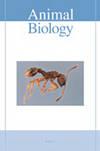不同肺形态蛇的心脏位置和肺血管系统
IF 0.9
4区 生物学
Q2 ZOOLOGY
引用次数: 0
摘要
蛇的呼吸系统由气管和一个或两个肺组成,在大小和复杂程度方面表现出相当大的变化,特别是在呼吸上皮的长度和分布方面。蛇心脏位置的重要性先前已被研究与重力压力有关。然而,呼吸气体交换上皮与心脏位置之间的关系尚未得到详细讨论,这似乎是必要的,因为心脏需要通过肺循环泵血以进行有效的气体交换。在此,我们分析了在呼吸系统的血管化部分的气体交换组织的组成和血管分布的组成方面,在蟒蛇和大角蟾呼吸上皮的立体形态学。气体交换上皮由毛细血管、大血管、小梁和间隔组成,在这两种动物中形成一个整体的小梁型上皮。肺毛细血管和呼吸表面积倾向于集中在每个肺呼吸上皮的前部和中部,表明这些区域有更大的实质发育的趋势。因此,心脏和肺循环的位置之间似乎没有结论性的关系,因为在硬囊c中,前实质和中间实质区域远离心脏,而在收缩b中,前实质和中间实质区域靠近心脏,促进心脏和气体交换上皮之间的血液运输。本文章由计算机程序翻译,如有差异,请以英文原文为准。
Heart position and pulmonary vasculature in snakes with different lung morphologies
The respiratory system of snakes, composed of a trachea and one or two lungs, shows considerable variation in terms of size and complexity, especially in terms of length and distribution of the respiratory epithelium. The importance of heart position within snakes has previously been investigated concerning gravitational stress. The relationship between respiratory gas exchange epithelium and heart position, however, has not been addressed in detail, which seems necessary, since the heart needs to pump blood through the pulmonary circulation for effective gas exchange. Herein, we analyze the morphology of the respiratory epithelium in Boa constrictor and Crotalus durissus stereologically regarding the composition of the gas exchange tissue and the distribution of blood vessels within the vascularized parts of the respiratory system. The gas exchange epithelium is composed of blood capillaries, larger vessels, trabeculae, and septa, forming an overall faveolar-type epithelium in both species. Pulmonary capillaries and respiratory surface area showed a tendency to be more concentrated in the anterior and middle portions of each lung’s respiratory epithelium, suggesting a tendency toward greater parenchymal development in these regions. Therefore, there seems to be no conclusive relationship between the position of the heart and pulmonary circulation, since in C. durissus the anterior and middle parenchymal regions are distant from the heart, whereas in B. constrictor the anterior and middle parenchymal regions are close to the heart, facilitating blood transport between the heart and the gas exchange epithelium.
求助全文
通过发布文献求助,成功后即可免费获取论文全文。
去求助
来源期刊

Animal Biology
生物-动物学
CiteScore
2.10
自引率
0.00%
发文量
34
审稿时长
3 months
期刊介绍:
Animal Biology publishes high quality papers and focuses on integration of the various disciplines within the broad field of zoology. These disciplines include behaviour, developmental biology, ecology, endocrinology, evolutionary biology, genomics, morphology, neurobiology, physiology, systematics and theoretical biology. Purely descriptive papers will not be considered for publication.
Animal Biology is the official journal of the Royal Dutch Zoological Society since its foundation in 1872. The journal was initially called Archives Néerlandaises de Zoologie, which was changed in 1952 to Netherlands Journal of Zoology, the current name was established in 2003.
 求助内容:
求助内容: 应助结果提醒方式:
应助结果提醒方式:


